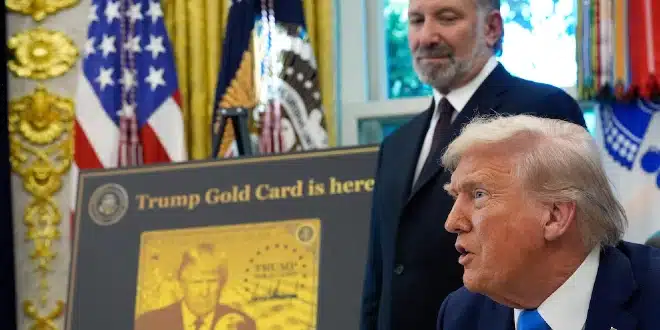U.S. President Donald Trump signed an executive order on Friday imposing a hefty $100,000 application fee on H-1B visas, framing the measure as a way to curb overuse of the program and encourage companies to hire American workers first. The decision marks one of the most dramatic attempts yet by his administration to reshape the U.S. immigration system and tighten control over foreign labor.
A Pricey New Hurdle for Skilled Worker Visas
Speaking from the Oval Office, Trump said the policy was intended to ensure that companies sponsor only the “best and brightest” foreign workers. “We need great workers, and this pretty much ensures that that’s what’s going to happen,” he declared.
Under the order, entry into the H-1B program—a work visa valid for three years, with the possibility of a three-year extension—will only be allowed if applicants or their sponsoring companies pay the new $100,000 fee. Commerce Secretary Howard Lutnick later explained that the administration is still finalizing details with the Department of Homeland Security, including whether firms would pay the $300,000 fee upfront or in yearly installments.
The move could have significant consequences for industries, particularly technology, that rely heavily on H-1B workers to fill specialized roles that U.S. labor markets struggle to supply. Economists have long argued that the program bolsters competitiveness and creates additional U.S. jobs, but critics of the system, including Trump’s populist base, have insisted it undercuts American workers by driving down wages.
The “Gold Card” Program: A Fast-Track for the Wealthy
Alongside the fee hike, Trump also announced the creation of a new immigration pathway dubbed the “gold card.” The program would allow wealthy foreign nationals to fast-track their U.S. visas by paying a $1 million fee, while employers could sponsor a foreign worker by paying $2 million.
Commerce Secretary Lutnick, who pitched the idea, said the initiative is designed to overhaul U.S. immigration priorities by favoring entrepreneurs and high earners over lower-income applicants. He criticized the traditional green card process, claiming it disproportionately brings in workers from “the bottom quartile” of the global labor market. “We’re going to only take extraordinary people at the very top,” Lutnick said.
Political Divisions and Shifting Positions
Trump’s stance on H-1B visas has shifted over the years, reflecting both his populist rhetoric and pressure from business leaders. During his first term, he repeatedly restricted the program, especially in 2020 during the COVID-19 pandemic, citing the need to protect American jobs. At the same time, he occasionally praised the system, even telling the New York Post in late 2024 that he was “a believer in H-1B.”
Entrepreneurs such as Elon Musk and Republican ally Vivek Ramaswamy have publicly defended the visa program, arguing that it is vital for attracting top global talent. Their support created friction within Trump’s base, where many hardline immigration opponents view H-1B visas as a loophole that undercuts American labor.
Demand and Competition
Every year, the U.S. grants 65,000 H-1B visas, with an additional 20,000 reserved for individuals holding advanced degrees from U.S. universities. Applications consistently outpace availability, forcing the government to use a lottery system to allocate spots.
Technology firms, in particular, have lobbied to expand access, saying they depend on foreign-born engineers, coders, and data specialists to meet demand. Without H-1B workers, many companies argue, they would lose ground in the global innovation race.
What This Means
Trump’s latest actions reflect his administration’s long-running effort to shift immigration policy toward restricting entry for lower-income workers while favoring elites and high-skilled talent. Supporters argue the measures will protect American jobs and prioritize “extraordinary” candidates. Critics warn, however, that the policies could choke industries reliant on skilled immigrants and place U.S. competitiveness at risk.
As with many of Trump’s immigration initiatives, the new policies are expected to generate sharp debate both domestically and abroad—highlighting the deep divide between advocates of economic nationalism and those pushing for a more open, innovation-driven approach to global labor.


